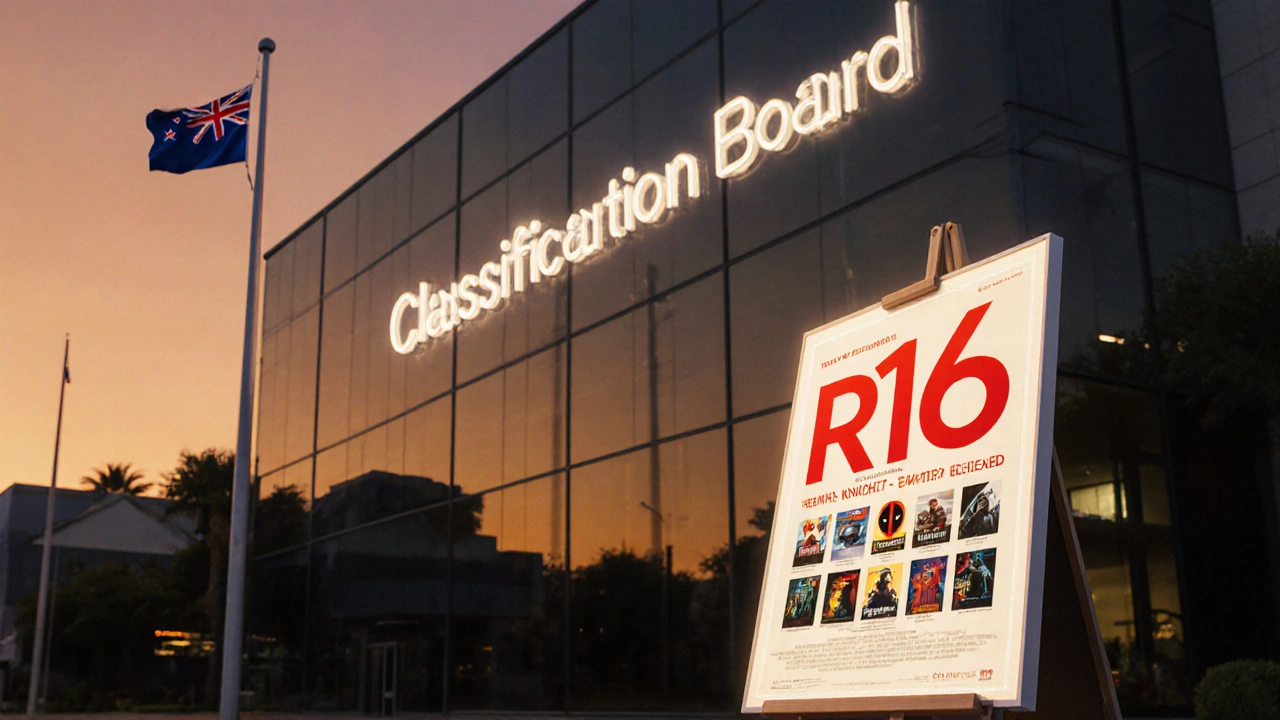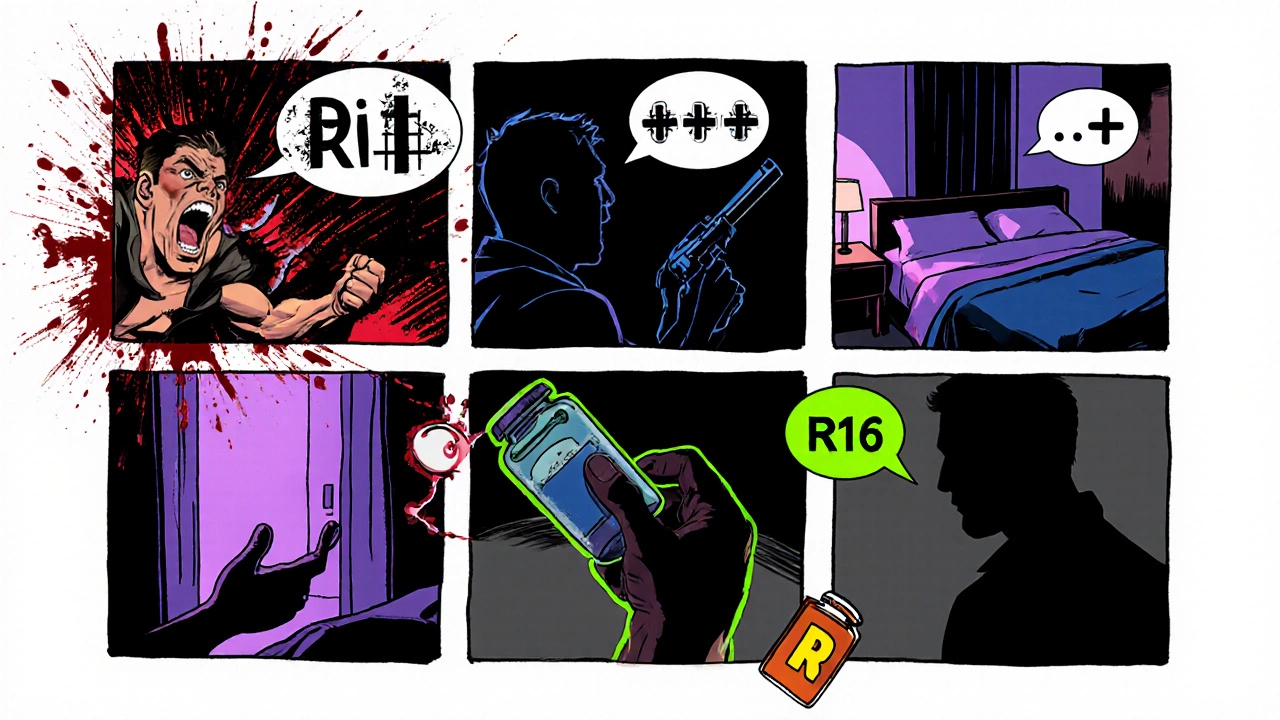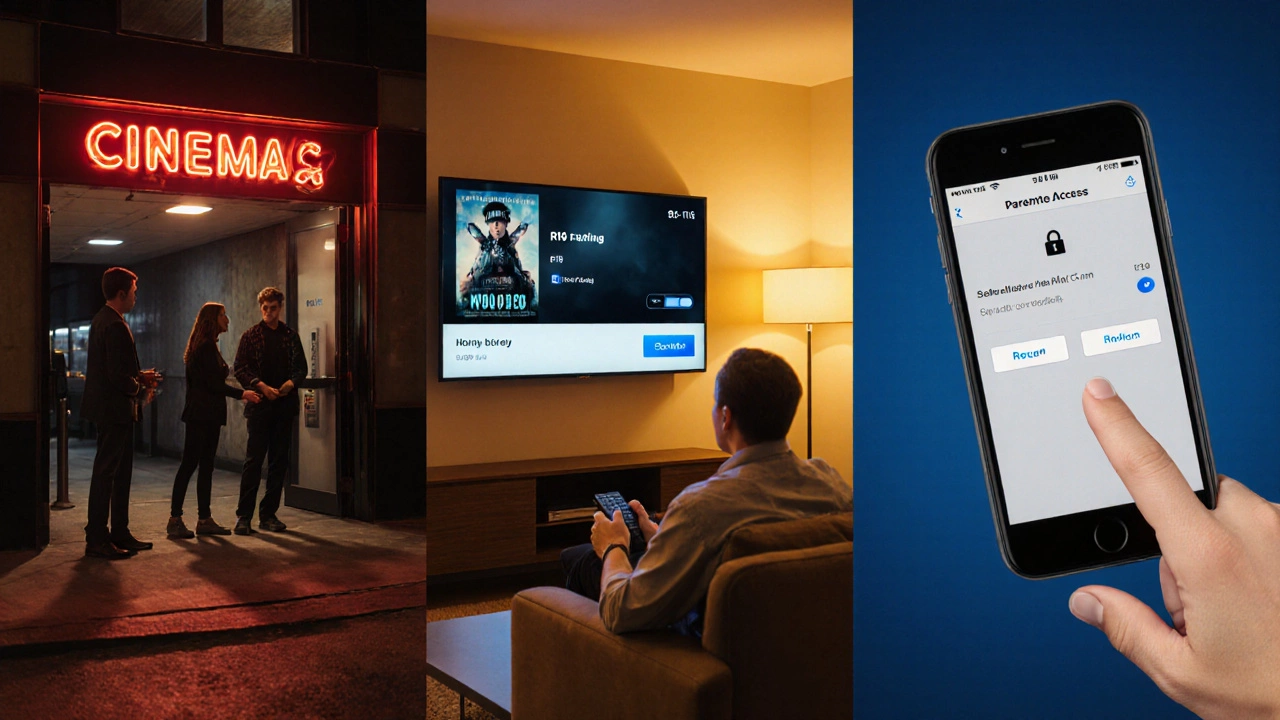Understanding the R16 Rating: What It Means for Movies and Viewers
 Oct, 10 2025
Oct, 10 2025
R16 Rating Explorer
- Violence Moderate to intense
- Language Strong profanity
- Sexual References Non-explicit
- Drug Use Depicted without glorification
- Dark Themes Mental illness, crime
| Rating | Minimum Age | Content Triggers | Regions |
|---|---|---|---|
| R13 | 13 | Moderate violence, limited profanity | Philippines |
| R16 | 16 | Strong language, intense violence, sexual references | New Zealand, Philippines |
| R18 | 18 | Explicit sexual content, graphic violence | Australia (R18+), New Zealand (R18) |
| PG-13 | 13 (recommended) | Some profanity, moderate violence | United States |
Myth: R16 means "adults only."
Reality: Only viewers 16 and over can watch without restrictions.
Myth: All R16 movies are violent.
Reality: Strong language or mature themes also qualify.
Myth: The rating is identical across countries.
Reality: Each nation applies its own criteria and thresholds.
Ever stared at a movie poster and wondered why it carries an R16 rating? You’re not alone. The label isn’t just a random number; it tells you exactly who the film is geared for and what kind of content you can expect. Below we break down the purpose of the R16 rating, where it’s used, which scenes trigger it, and how it compares to other common ratings.
What is the R16 rating?
R16 rating is a film classification that restricts admission to viewers aged 16 and older. It is primarily employed by the New Zealand Classification Office, the government agency that decides what can be shown publicly. The rating signals that the film may contain strong language, moderate violence, or sexual references that are unsuitable for younger audiences.
Who decides the R16 rating?
The authority behind the rating is the New Zealand Classification Office, often referred to as the NZ Classification Board. This board follows the Film Classification Act 1993 and evaluates each submission against a set of content guidelines. Their goal is to balance artistic freedom with public protection.
Where is the R16 rating used?
While New Zealand is the most recognized user of the R16 label, a handful of other regions have similar age‑based restrictions:
- Philippines - uses R-16 for movies with strong language or moderate violence.
- Australia - the closest equivalent is MA15+, which allows viewers 15 and up with parental guidance.
- Canada (Ontario) - employs a 14A rating, but the concept mirrors R16’s purpose.
These variations exist because each country's censorship board tailors its thresholds to cultural norms, but the underlying principle-a safeguard for younger viewers-remains the same.
What kind of content triggers an R16 rating?
To earn an R16 label, a film typically includes one or more of the following elements:
- Violence: Moderate to intense fight scenes, blood, or realistic weapon use.
- Language: Frequent use of strong profanity (e.g., the f‑word) in a non‑comic context.
- Sexual references: Non‑explicit sexual dialogue or scenes suggesting sexual activity.
- Drug use: Depiction of illegal substance consumption without glorification.
- Themes: Dark or unsettling subject matter such as mental illness or crime.
Each element is weighed against the board’s Content Advisory Guidelines. If the cumulative impact crosses the 16‑year threshold, the board applies the R16 rating.

Real‑world examples of R16‑rated films
Seeing the rating in action helps clarify its scope. Here are a few notable titles that received an R16 classification in New Zealand:
- The Dark Knight - for intense violence and strong language.
- Deadpool - due to graphic humor, sexual jokes, and frequent profanity.
- Whiplash - for harsh language and intense psychological pressure.
- The Matrix Reloaded - for stylized violence and brief sexual content.
These films demonstrate that an R16 label isn’t limited to a single genre; it spans action, comedy, drama, and sci‑fi.
How does the R16 rating affect you as a viewer?
If you’re 16 or older, you can watch an R16‑rated movie in any cinema, on streaming platforms, or via home video without restrictions. Below‑16 audiences, however, face three possible outcomes:
- They are turned away at the theater entrance.
- Streaming services block the title unless an adult authorizes it.
- Parents may choose to view the content first and decide whether to allow it.
This system aims to give parents a clear signal while letting adults access a broader range of storytelling.
R16 versus other common ratings
| Rating | Minimum Age | Typical Content Triggers | Primary Regions |
|---|---|---|---|
| R13 | 13 | Moderate violence, limited profanity, mild sexual themes | Philippines |
| R16 | 16 | Strong language, intense violence, sexual references, drug use | New Zealand, Philippines (variant) |
| R18 | 18 | Explicit sexual content, graphic violence, hardcore drug scenes | Australia (R18+), New Zealand (R18) |
| PG‑13 | 13 (recommended) | Some profanity, moderate violence, brief sexual innuendo | United States |
The table makes clear where the R16 slot sits on the spectrum: stricter than a teen‑friendly PG‑13 but less restrictive than an adult‑only R18.
Why the R16 rating matters to filmmakers
For directors and producers, the classification can shape creative decisions. Knowing that a film will be labeled R16 allows them to:
- Include realistic violence without fearing an outright ban.
- Use stronger language to maintain authentic dialogue.
- Target an older teen audience, which can boost box‑office returns in markets where 16‑plus viewers are a key demographic.
At the same time, the rating acts as a safety net, ensuring that content deemed too extreme for younger viewers doesn’t slip through unchecked.

Common myths about the R16 rating
Myth #1: R16 means the film is “for adults only.”
Reality: The rating simply restricts viewers under 16; adults can watch without extra scrutiny.
Myth #2: All R16 movies are violent.
Reality: Some earn the label solely for strong language or mature themes, not necessarily for bloodshed.
Myth #3: The rating is the same everywhere.
Reality: Different countries apply different criteria, so an R16 film in New Zealand might be rated PG‑13 elsewhere.
How to quickly check a film’s rating
Most online ticketing platforms display the rating next to the title. For streaming services, look for the “Details” or “Info” pane. If you’re still unsure, visit the New Zealand Classification Office website and use their searchable database-just type the movie name and the rating pops up instantly.
What to do if you disagree with an R16 rating
Viewers can submit a formal objection to the NZ Classification Board. The process involves:
- Filling out an online appeal form providing specific concerns.
- Supplying time‑stamped clips that illustrate the disputed content.
- Waiting for a hearing, after which the board may uphold, downgrade, or upgrade the rating.
While appeals are rare, the system ensures transparency and community involvement.
Frequently Asked Questions
Can a 15‑year‑old watch an R16 movie with parental permission?
In NewZealand, the law requires the viewer to be at least 16, even with parental consent. However, private home viewing is not strictly policed, so many parents allow it at their discretion.
Does the R16 rating affect streaming platforms like Netflix?
Yes. Netflix and other services tag each title with its official classification. If your account is set for a user under 16, the platform will hide R16 titles by default.
Are there any movies that moved from R16 to PG‑13 after re‑editing?
Yes. Some distributors edit out explicit language or trim violent scenes to meet a lower rating for broader release. For example, the original cut of "Deadpool" was initially R16, but a censored version was later approved as PG‑13 in certain markets.
How does the R16 rating compare to the U.S. R rating?
The U.S. "R" rating restricts viewers under 17 unless accompanied by an adult, while NewZealand's R16 bars anyone under 16 completely. Both allow strong content, but the age thresholds differ slightly.
Where can I find a complete list of R16‑rated films?
The NZ Classification Office maintains a searchable catalogue. By selecting the "R16" filter, you can view every title that carries the rating, along with synopses and content warnings.